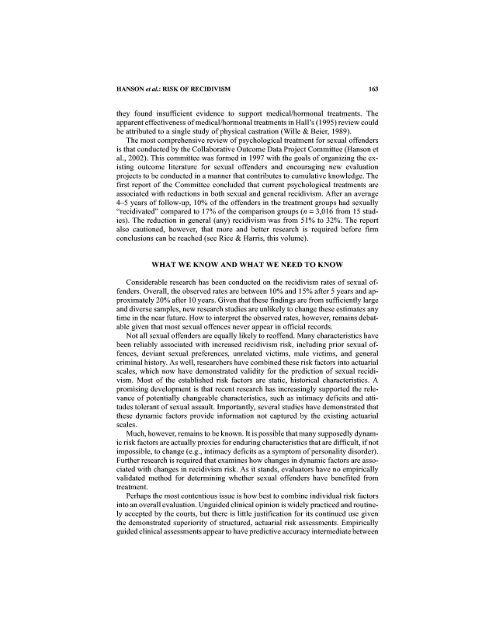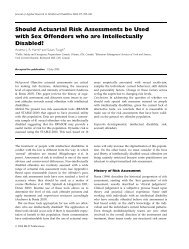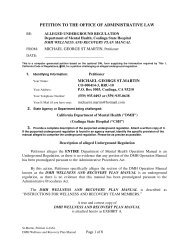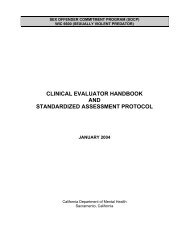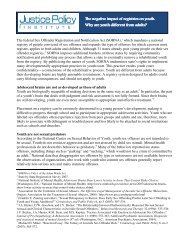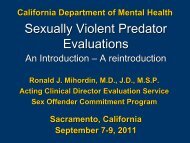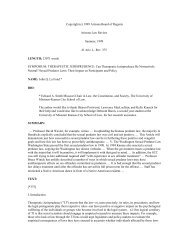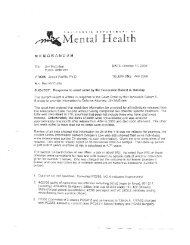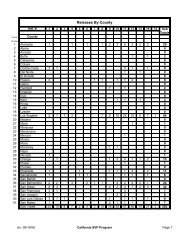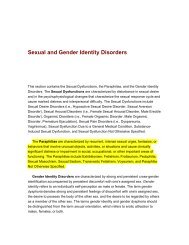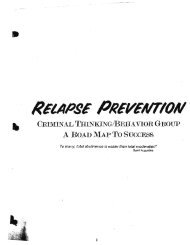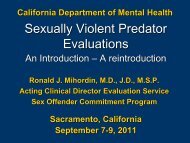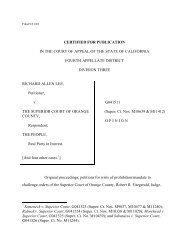Hanson Morton Harris 2003 - Defense for SVP
Hanson Morton Harris 2003 - Defense for SVP
Hanson Morton Harris 2003 - Defense for SVP
You also want an ePaper? Increase the reach of your titles
YUMPU automatically turns print PDFs into web optimized ePapers that Google loves.
HANSON et al.: RISK OF RECIDIVISM 163<br />
they found insufficient evidence to support medicallhormonal treatments. The<br />
apparent effectiveness ofmedicallhormonal treatments in Hall's (1995) review could<br />
be attributed to a single study of physical castration (Wille & Beier, 1989).<br />
The most comprehensive review of psychological treatment <strong>for</strong> sexual offenders<br />
is that conducted by the Collaborative Outcome Data Project Committee (<strong>Hanson</strong> et<br />
aI., 2002). This committee was <strong>for</strong>med in 1997 with the goals of organizing the existing<br />
outcome literature <strong>for</strong> sexual offenders and encouraging new evaluation<br />
projects to be conducted in a manner that contributes to cumulative knowledge. The<br />
first report of the Committee concluded that current psychological treatments are<br />
associated with reductions in both sexual and general recidivism. After an average<br />
4-5 years of follow-up, 10% of the offenders in the treatment groups had sexually<br />
"recidivated" compared to 17% of the comparison groups (n = 3,016 from 15 studies).<br />
The reduction in general (any) recidivism was from 51% to 32%. The report<br />
also cautioned, however, that more and better research is required be<strong>for</strong>e firm<br />
conclusions can be reached (see Rice & <strong>Harris</strong>, this volume).<br />
WHAT WE KNOW AND WHAT WE NEED TO KNOW<br />
Considerable research has been conducted on the recidivism rates of sexual offenders.<br />
Overall, the observed rates are between 10% and 15% after 5 years and approximately<br />
20% after 10 years. Given that these findings are from sufficiently large<br />
and diverse samples, new research studies are unlikely to change these estimates any<br />
time in the near future. How to interpret the observed rates, however, remains debatable<br />
given that most sexual offences never appear in official records.<br />
Not all sexual offenders are equally likely to reoffend. Many characteristics have<br />
been reliably associated with increased recidivism risk, including prior sexual offences,<br />
deviant sexual preferences, unrelated victims, male victims, and general<br />
criminal history. As well, researchers have combined these risk factors into actuarial<br />
scales, which now have demonstrated validity <strong>for</strong> the prediction of sexual recidivism.<br />
Most of the established risk factors are static, historical characteristics. A<br />
promising development is that recent research has increasingly supported the relevance<br />
of potentially changeable characteristics, such as intimacy deficits and attitudes<br />
tolerant of sexual assault. Importantly, several studies have demonstrated that<br />
these dynamic factors provide in<strong>for</strong>mation not captured by the existing actuarial<br />
scales.<br />
Much, however, remains to be known. It is possible that many supposedly dynamic<br />
risk factors are actually proxies <strong>for</strong> enduring characteristics that are difficult, if not<br />
impossible, to change (e.g., intimacy deficits as a symptom of personality disorder).<br />
Further research is required that examines how changes in dynamic factors are associated<br />
with changes in recidivism risk. As it stands, evaluators have no empirically<br />
validated method <strong>for</strong> determining whether sexual offenders have benefited from<br />
treatment.<br />
Perhaps the most contentious issue is how best to combine individual risk factors<br />
into an overall evaluation. Unguided clinical opinion is widely practiced and routinely<br />
accepted by the courts, but there is little justification <strong>for</strong> its continued use given<br />
the demonstrated superiority of structured, actuarial risk assessments. Empirically<br />
guided clinical assessments appear to have predictive accuracy intermediate between


